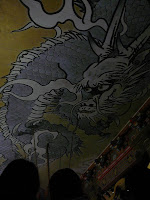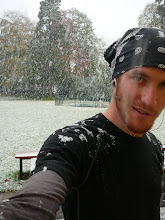 We didn't get to bed until about 2am, after finishing up a rather unfruitful session in the Manga cafe, and then woke up at 6am to get ready for our day about 2 hours north of Tokyo in the beautiful, sacred town of Nikko.
We didn't get to bed until about 2am, after finishing up a rather unfruitful session in the Manga cafe, and then woke up at 6am to get ready for our day about 2 hours north of Tokyo in the beautiful, sacred town of Nikko.  This town, like many of Japan's towns and cities, are steeped in history with sacred sites dating back to the middle of the 8th century. For many years Nikko was a famous training centre for Buddhist monks before these activities were moved elsewhere and the area became
This town, like many of Japan's towns and cities, are steeped in history with sacred sites dating back to the middle of the 8th century. For many years Nikko was a famous training centre for Buddhist monks before these activities were moved elsewhere and the area became  relatively unknown. Hundreds of years later, in 1617, a warlord by the name of Tokugawa Ieyasu was buried in the cedar forest here, a shrine dedicated to him beginning the site's climb back out of
relatively unknown. Hundreds of years later, in 1617, a warlord by the name of Tokugawa Ieyasu was buried in the cedar forest here, a shrine dedicated to him beginning the site's climb back out of  obscurity. Tokugawa was a notorious leader determined to take control of Japan and is attributed with having had his wife and eldest son executed because it was politically advantageous for him to do so at the time. Nice guy... Nevertheless, these days the area is lovely and dotted with colourful pagodas and shrines, many of them we managed to visit during our short time there.
obscurity. Tokugawa was a notorious leader determined to take control of Japan and is attributed with having had his wife and eldest son executed because it was politically advantageous for him to do so at the time. Nice guy... Nevertheless, these days the area is lovely and dotted with colourful pagodas and shrines, many of them we managed to visit during our short time there.Rinno-ji was the first stop, the main feature of which is the Sambutsu-do (Three Buddha Hall), where - you guessed it - three huge gold Buddhas reside, watching over you as you walk through their domain.
 Tosho-gu, one of the largest and, in my opinion, one of the most impressive shrines in the area is the
Tosho-gu, one of the largest and, in my opinion, one of the most impressive shrines in the area is the  shrine built for the lovely fellow I mentioned before, Tokugawa Ieyasu, and is entered by passing through a huge stone torii (a Shinto shrine entrance gate in the shape of the Greek letter π). This shrine is home to the original carving of the "Hear no evil, Speak no evil, See no evil" monkeys, which actually look a lot different to any other versions I have seen before. This prompted Lee and I to try our own version, which of course we executed perfectly :P
shrine built for the lovely fellow I mentioned before, Tokugawa Ieyasu, and is entered by passing through a huge stone torii (a Shinto shrine entrance gate in the shape of the Greek letter π). This shrine is home to the original carving of the "Hear no evil, Speak no evil, See no evil" monkeys, which actually look a lot different to any other versions I have seen before. This prompted Lee and I to try our own version, which of course we executed perfectly :P In this temple is also the other famous carving of elephants by an artist who had not previously ever seen the animal. Just past this carving, and through another torii, is an extremely busy and detailed gate which boasts paintings of flowers, girls dancing and mythical beasts all amongst gold leaf and red lacquer-work. Apparently the designers of this gate were worried that it was possibly too
In this temple is also the other famous carving of elephants by an artist who had not previously ever seen the animal. Just past this carving, and through another torii, is an extremely busy and detailed gate which boasts paintings of flowers, girls dancing and mythical beasts all amongst gold leaf and red lacquer-work. Apparently the designers of this gate were worried that it was possibly too  perfect and that this could anger the gods, and so they purposefully placed the final pillar in upside-down to maintain the peace.
perfect and that this could anger the gods, and so they purposefully placed the final pillar in upside-down to maintain the peace. Lunch was in a small restaurant where we were approached by a group of Japanese ladies from a World Peace group. They gave us a whole bunch of cool little handmade items, paper foldings, etc. Not sure why, I suppose to spread the word.. but turns out one of them used to organise Japanese exchange students going to Adelaide -
 what a coincidence: we had a Japanese exchange student, Shiori, come stay with us many years ago.. I thin
what a coincidence: we had a Japanese exchange student, Shiori, come stay with us many years ago.. I thin k it was a bit of a stretch to assume she had something to do with our particular case, but she couldn't confirm either way so it's always possible..
k it was a bit of a stretch to assume she had something to do with our particular case, but she couldn't confirm either way so it's always possible..After all the temple fun, we had a bit of a walk about this quite aesthetically pleasing town, a little reminiscent of Austria's Salzburg I felt (possibly due to the mountainous terrain, or maybe I am just thinking of Salzburg for some reason..?). There is a red bridge, Shin-kyo, that is said to have been built on the spot where a local Buddhist monk from the 8th century was carried across the river on the back of two huge serpents - fact or fiction? You decide..
 Our final stop before the 2 hour train trip back to the big smoke was
Our final stop before the 2 hour train trip back to the big smoke was  Gamman-ga-fuchi Abyss, a quiet and out-of-the-way place at the end of a small alleyway which follows the winding river. Here there are many (some say an uncountable number of) statues of jizo, the Buddhist protector of travellers and children, set along a path. Halfway along is one statue known as Bake-jizo, who mocks any travellers foolish enough to try count all the statues - personally, I could have done it but chose not to.. Honestly..
Gamman-ga-fuchi Abyss, a quiet and out-of-the-way place at the end of a small alleyway which follows the winding river. Here there are many (some say an uncountable number of) statues of jizo, the Buddhist protector of travellers and children, set along a path. Halfway along is one statue known as Bake-jizo, who mocks any travellers foolish enough to try count all the statues - personally, I could have done it but chose not to.. Honestly..That night we settled into a cozy restaurant in Ginza for some very tasty yakitori. Here another couple sitting next to us decided to give us some little gifts aswell.. Strange day, the day of giving..
Photos:
1. on the train
2. Lucky dip!
3. the ladles used for ritual cleansing
4. Taiyuin-byo shrine
5. The stone torii
6. 5-storey pagoda
7. Hear no evil, Speak no evil, See no evil - the original monkeys in the background..
8. Elaborate carvings..
9. A bell house
10. Tosho-gu temple
11. the jizo statues.. spot the odd one out?
12. Awesome painting on the ceiling of a temple


2 comments:
hey paul. The Japanese seem to be very different natured to the Vietnamese. You are describing a very peaceful place. I do love your blogs.
Thanks for the hear no evil, speak no evil, see no evil pic.. it's now my background.. love it :)
Post a Comment